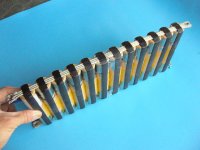Hi everyone,
I've got a question regarding how much force one could apply to a cylindrical lithium cell (LiFePo4 in this case).
My plan was to build blocks of 32700 cells and clamp them together (plus to minus to get series connections).
However, this would mean that quite a lot of force would be exerted on the cells (longitudinal).
Would this be an issue? I could imagine it isn't ideal, especially for the plus side. When the positive or negative terminal is bent inward due to the force, could it even deform the jelly roll inside?
The force would especially be great when the battery is upright, because there is also the gravitational force of all the blocks on the bottom one, that force could easily reach 20N(2kg/4lbs) per cell.
So what are your thoughts? Is it ok to put a 20N force on a 32700 cel? Is there a clearance between the terminals and the jelly roll?
I tried applying force, nothing much happens and the terminals don't seem to deform much, but maybe it isn't advisable over the long term?
I'd love to hear your thoughts!
I've got a question regarding how much force one could apply to a cylindrical lithium cell (LiFePo4 in this case).
My plan was to build blocks of 32700 cells and clamp them together (plus to minus to get series connections).
However, this would mean that quite a lot of force would be exerted on the cells (longitudinal).
Would this be an issue? I could imagine it isn't ideal, especially for the plus side. When the positive or negative terminal is bent inward due to the force, could it even deform the jelly roll inside?
The force would especially be great when the battery is upright, because there is also the gravitational force of all the blocks on the bottom one, that force could easily reach 20N(2kg/4lbs) per cell.
So what are your thoughts? Is it ok to put a 20N force on a 32700 cel? Is there a clearance between the terminals and the jelly roll?
I tried applying force, nothing much happens and the terminals don't seem to deform much, but maybe it isn't advisable over the long term?
I'd love to hear your thoughts!


